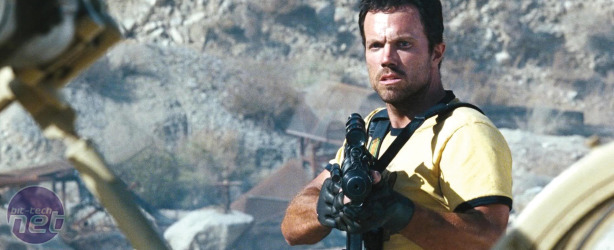How we test projectors
When we review projectors, there are a number of elements we bear in mind. The first is the design of the chassis, and how easy it is to set up and achieve a correctly shaped picture.However, we don't emphasise looks, as while the aesthetics will have an impact, you’ll hopefully spend your time looking at the projector’s output and not the unit itself.
We're more interested in features such as lens shift, which enables the lens to be moved around to fit the image on your screen, rather than having to position the whole projector in the optimal place. The closer the projector is to the screen, the tougher it is to project a large image, so our test environment was a challenge in that regard.
We project onto an 82in, freestanding pull-down Optoma 16:9 aspect ratio Panoview screen from a desk 3.3m away. As well as lens shift, we look for effective aids such as extending feet and stands that really help with the setup process.
We also look for features inside the projector, such as digital keystone correction; while this should only be used as a last resort, it can help to obtain the correct picture shape when it isn’t possible to position the projector in just the right place.
While action movies and games are usually loud and booming affairs, there might well be quieter moments, so we took note of whether fan noise is obtrusive. The number and type of inputs are also important factors; if you aren’t connecting via an AV amp, you’ll spend half your time switching cables.
The main consideration, though, is image quality. You can deal with awkward setups, but if the picture isn’t up to scratch, you’re stuck with it. As such, we examined the options for adjusting the picture.
From previous experience we know that the quoted contrast ratios and brightness figures need to be taken with a pinch of salt. While the contrast ratio is important, manufacturers can achieve high figures with very bright, over-boosted pictures that are actually unwatchable.
As such, we run seven separate real-world tests to determine how well each projectors performs. First, we hook each projector over HDMI to a system fitted with an ATI Radeon HD 4850. All the tests were run at the projectors’ native resolution – either 1,280 x 720 (720p) or 1,920 x 1080 (1080p).
The first hurdle each projector has to pass is to display the Lagom test images. We pay particular attention to the contrast test (which shows how the projector handles RGB colour scaling), the sharpness test, the black level and white saturation tests (to determine if they can display darker and lighter areas and how cleanly they can do this) and the gradient test.
We also look at how the projector handles large blocks of colours – purple, red and green. We used a rolling demo of the game X3: Terran Conflict, for a good test of black levels, colour rendition and motion. The next game we play is Crysis, where we use the extensive greenery of the grass, trees and bushes to evaluate colour performance, and played the game to test fast motion.
Finally, we played the 1080p QuickTime trailer of Serenity to see how each projector handles motion and shadow detail, and to find out how it coped with the noise from this relatively low bit-rate file.
We then hooked up a PlayStation 3 and play three demanding discs. The first comprised two scenes from our venerable test DVD, The Lord of the Rings: The Fellowship of the Ring.
There are two particularly demanding scenes: the intense white snow, as the Fellowship crosses the mountain pass Caradhras; and the scene when Frodo rolls and drops the ring, which is good for testing skin tones and the visible detail in the hair and clothes, making it ideal for evaluating upscaler performance. Black levels are also put to a stern test when Gandalf lights up his staff in the pitch black as they enter the Mines of Moria.
After that, we used the Pixar movie Cars to test bright intense colours, and finally we tested native HD performance and black levels with the opening scenes of The Matrix on Blu-ray.

MSI MPG Velox 100R Chassis Review
October 14 2021 | 15:04













Want to comment? Please log in.